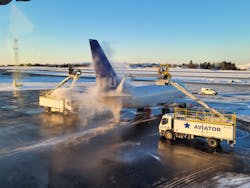Aviator Shares Insights and Highlights from a Challenging Deicing Season
While most Europeans have already been living with summer in their minds, Aviator Airport Alliance, a full-range provider of aviation services at 15 airports across the Nordics, has just ended their deicing season. After months of active operation, Magnus Söderberg, business improvement director at Aviator, is sharing insights on the past season.
“Aviator had an exceptionally active winter,” Söderberg shares. “Our standard season typically spans from October to April or early May, but in our Arctic Circle stations, Bardufoss and Tromsø, it commences on September 15 and concludes on May 15. This year was no different, and we even experienced snow just last week. Although the season's duration remained unchanged, we witnessed an increase of approximately 30 percent in the number of deicings performed compared to the previous winter.”
Deicing operations take place at 12 out of the 15 Aviator bases, with Norway's stations being the most active.
“Our two stations located above the Arctic Circle had the highest deicing intensity, where more than every second aircraft undergoes deicing during the season. In Sweden, Stockholm Arlanda experienced the highest volume of deicing operations, followed by Gothenburg, and Helsinki in Finland,” Söderberg elaborates.
According to Söderberg, the duration of aircraft deicing can vary significantly, ranging from as little as 2 minutes to up to 1 hour. Several factors come into play, including the size of the aircraft, prevailing weather conditions, and even the infrastructure of the airport.
“For instance, a morning deicing session to address light frost typically requires approximately 3-4 minutes, including debriefing, when handled by an experienced crew. When deicing is performed amidst snowfall, it generally takes around 8-10 minutes. However, in cases of heavy snowfall or if the aircraft has been parked for an extended period, leading to substantial ice or contamination build-up, the deicing process may necessitate the involvement of two trucks and span approximately 15-20 minutes or even longer,” he says.
Söderberg highlights that this season has truly tested several Aviator stations.
“The most significant challenges typically arise from unpredictable weather conditions. This year, at Bergen Airport, heavy snowfall began in mid-November, a little later than usual but more intense straight away. The winter season there lasted until early May. Tromsø Airport experienced severe wind conditions and encountered multiple storms. At Bardufoss Airport, temperatures plummeted to minus 30 degrees Celsius. For instance, there was an aircraft parked there for several days during the extreme cold. At first, it was covered with wet snow but when the temperature dropped to minus 18 degrees Celsius, the snow transformed into a 10 cm thick layer of ice. To deice the aircraft, we had to utilize more than 19,000 liters of deicing mix,” he says
He added that extreme winter conditions place significant demands on a deicing organization.
“In cases of heavy precipitation, deicing the entire aircraft becomes necessary, not just the wings and stabilizers, which naturally extends the duration of the treatment. Additionally, during such conditions, we often have to manually remove snow from jet engines, propellers, and other critical areas,” Söderberg says.
With the closure of the deicing season, Aviator now shifts its focus to active summer operations. However, there is no time to spare, as preparations for the next winter season are already underway.
“As soon as the season ends, we initiate the process of overhauling our existing equipment. Throughout the season, we also conduct regular equipment checks. Typically, major inspections occur in May or June, varying based on the station's location. Following that, we perform an inventory assessment of our equipment in relation to our customer base, determining whether any investments are required or if we have a surplus of equipment. Repetition training for our existing staff begins after the summer period since all our deicing personnel undergo annual training to ensure their skills remain sharp. Finally, a comprehensive evaluation is conducted to determine if additional staff training is necessary for the upcoming season,” Söderberg says.
Aviator Airport Alliance provides high-quality ground handling services: from passenger and baggage handling to deicing, cargo and full-freight handling, to station services, including airport security and the Nordic Dino aircraft washing robot. The company is a family member of Avia Solutions Group – the world’s largest ACMI (aircraft, crew, maintenance, and insurance) provider with 173 aircraft fleet, operating on all continents in the world.
